Arm Announces Mobile Armv9 CPU Microarchitectures: Cortex-X2, Cortex-A710 & Cortex-A510
by Andrei Frumusanu on May 25, 2021 9:00 AM EST- Posted in
- SoCs
- CPUs
- Arm
- Smartphones
- Mobile
- Cortex
- ARMv9
- Cortex-X2
- Cortex-A710
- Cortex-A510
The Cortex-X2: More Performance, Deeper OoO
We first start off with the Cortex-X2, successor to last year’s Cortex-X1. The X1 marked the first in a new IP line-up from Arm which diverged its “big” core offering into two different IP lines, with the Cortex-A sibling continuing Arm’s original design philosophy of PPA, while the X-cores are allowed to grow in size and power in order to achieve much higher performance points.
The Cortex-X2 continues this philosophy, and further grows the performance and power gap between it and its “middle” sibling, the Cortex-A710. I also noticed that throughout Arm’s presentation there were a lot more mentions of having the Cortex-X2 being used in larger-screen compute devices and form-factors such as laptops, so it might very well be an indication of the company that some of its customers will be using the X2 more predominantly in such designs for this generation.
From an architectural standpoint the X2 is naturally different from the X1, thanks in large part to its support for Armv9 and all of the security and related ISA platform advancements that come with the new re-baselining of the architecture.
As noted in the introduction, the Cortex-X2 is also a 64-bit only core which only supports AArch64 execution, even in PL0 user mode applications. From a microarchitectural standpoint this is interesting as it means Arm will have been able to kick out some cruft in the design. However as the design is a continuation of the Austin family of processors, I do wonder if we’ll see more benefits of this deprecation in future “clean-sheet” big cores designs, where AArch64-only was designed from the get-go. This, in fact, is something that's already happening in other members of Arm's CPU cores, as the new little core Cortex-A510 was designed sans-AArch32.
Starting off with the front-end, in general, Arm has continued to try to improve what it considers the most important aspect of the microarchitecture: branch prediction. This includes continuing to run the branch resolution in a decoupled way from the fetch stages in order to being able to have these functional blocks be able to run ahead of the rest of the core in case of mispredicts and minimize branch bubbles. Arm generally doesn’t like to talk too much details about what exactly they’ve changed here in terms of their predictors, but promises a notable improvement in terms of branch prediction accuracy for the new X2 and A710 cores, effectively reducing the MPKI (Misses per kilo instructions) metric for a very wide range of workloads.
The new core overall reduces its pipeline length from 11 cycles to 10 cycles as Arm has been able to reduce the dispatch stages from 2-cycles to 1-cycle. It’s to be noted that we have to differentiate the pipeline cycles from the mispredict penalties, the latter had already been reduced to 10 cycles in most circumstances in the Cortex-A77 design. Removing a pipeline stage is generally a rather large change, particularly given Arm’s target of maintaining frequency capabilities of the core. This design change did incur some more complex engineering and had area and power costs; but despite that, as Arm explains in, cutting a pipeline stage still offered a larger return-on-investment when it came to the performance benefits, and was thus very much worth it.
The core also increases its out-of-order capabilities, increasing the ROB (reorder buffer) by 30% from 224 entries to 288 entries this generation. The effective figure is actually a little bit higher still, as in cases of compression and instruction bundling there are essentially more than 288 entries being stored. Arm says there’s also more instruction fusion cases being facilitated this generation.
On the back-end of the core, the big new change is on the part of the FP/ASIMD pipelines which are now SVE2-capable. In the mobile space, the SVE vector length will continue to be 128b and essentially the new X2 core features similar throughput characteristics to the X1’s 4x FP/NEON pipelines. The choice of 128b vectors instead of something higher is due to the requirement to have homogenous architectural feature-sets amongst big.LITTLE designs as you cannot mix different vector length microarchitectures in the same SoC in a seamless fashion.
On the back-end, the Cortex-X2 continues to focus on increasing MLP (memory level parallelism) by increasing the load-store windows and structure sizes by 33%. Arm here employs several structures and generally doesn’t go into detail about exactly which queues have been extended, but once we get our hands on X2 systems we’ll be likely be able to measure this. The L1 dTLB has grown from 40 entries to 48 entries, and as with every generation, Arm has also improved their prefetchers, increasing accuracies and coverage.
One prefetcher that surprised us in the Cortex-X1 and A78 earlier this year when we first tested new generation devices was a temporal prefetcher – the first of its kind that we’re aware of in the industry. This is able to latch onto arbitrary repeated memory patterns and recognize new iterations in memory accesses, being able to smartly prefetch the whole pattern up to a certain depth (we estimate a 32-64MB window). Arm states that this coverage is now further increased, as well as the accuracy – though again the details we’ll only able to see once we get our hands on silicon.
In terms of IPC improvements, this year’s figures are quoted to reach +16% in SPECint2006 at ISO frequency. The issue with this metric (and which applies to all of Arm’s figures today) is that Arm is comparing an 8MB L3 cache design to a 4MB L3 design, so I expect a larger chunk of that +16% figure to be due to the larger cache rather than the core IPC improvements themselves.
For their part, Arm is reiterating that they're expecting 8MB L3 designs for next year’s X2 SoCs – and thus this +16% figure is realistic and is what users should see in actual implementations. But with that said, we had the same discussion last year in regards to Arm expecting 8MB L3 caches for X1 SoCs, which didn't happen for either the Exynos 2100 nor the Snapdragon 888. So we'll just have to wait and see what cache sizes the flagship commercial SoCs end up going with.
In terms of the performance and power curve, the new X2 core extends itself ahead of the X1 curve in both metrics. The +16% performance figure in terms of the peak performance points, though it does come at a cost of higher power consumption.
Generally, this is a bit worrying in context of what we’re seeing in the market right now when it comes to process node choices from vendors. We’ve seen that Samsung’s 5LPE node used by Qualcomm and S.LSI in the Snapdragon 888 and Exynos 2100 has under-delivered in terms of performance and power efficiency, and I generally consider both big cores' power consumption to be at a higher bound limit when it comes to thermals. I expect Qualcomm to stick with Samsung foundry in the next generation, so I am admittedly pessimistic in regards to power improvements in whichever node the next flagship SoCs come in (be it 5LPP or 4LPP). It could well be plausible that we wouldn’t see the full +16% improvement in actual SoCs next year.


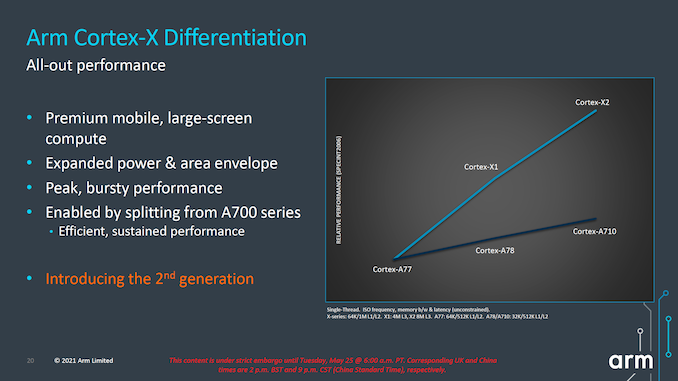
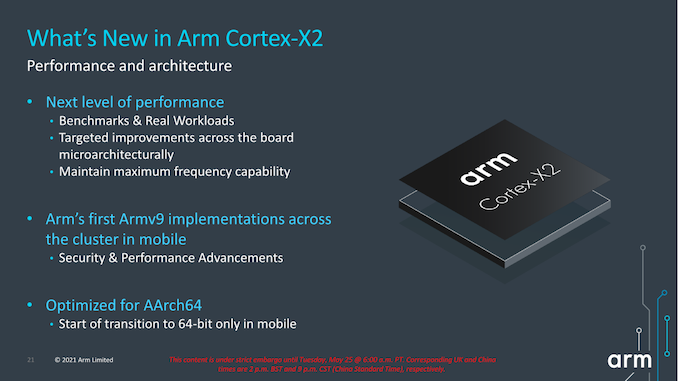
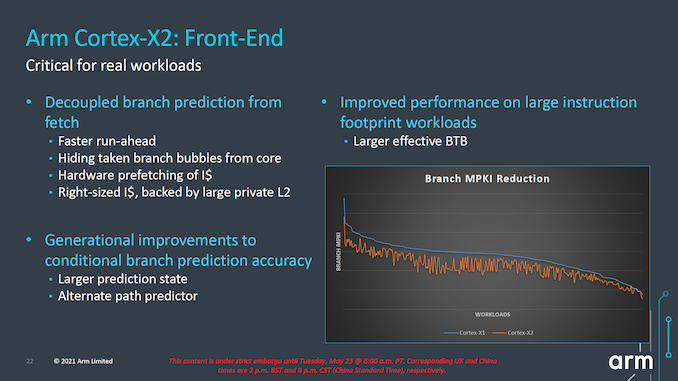
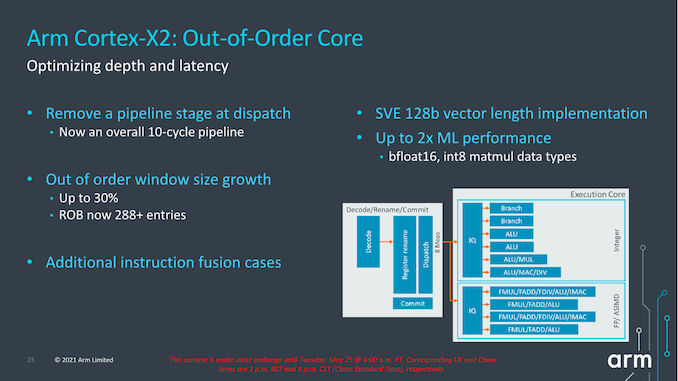
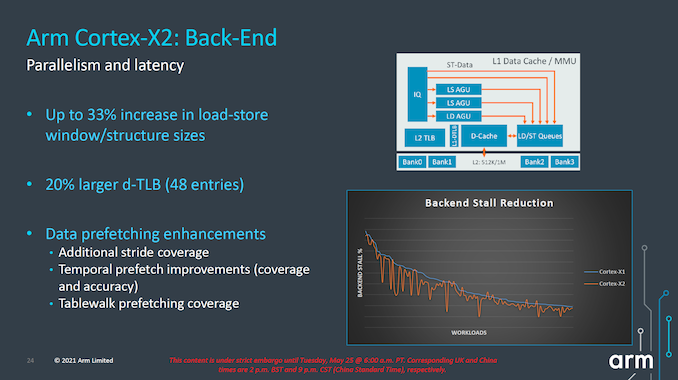
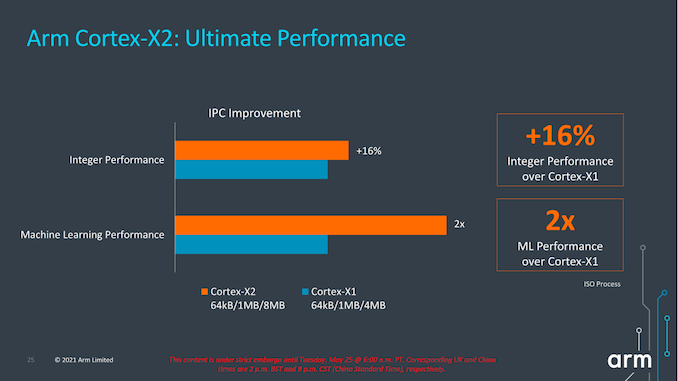









181 Comments
View All Comments
name99 - Tuesday, May 25, 2021 - link
Inrinsity was about circuit design.PA Semi was about microarchitecture.
There was a *lot* of good stuff in PA Semi! I have looked quickly at quite a few of the Intrinsity patents, but I don't know enough about that level of the stack to have any option as to how impressive they were. (This is not a criticism -- even if all that was picked up from Intrinsity was a number of competent engineers capable of implementing the micro-architecture ideas of the PA Semi folks, that's an essential part of shipping a chip!)
I'd honestly love someone who is familiar with the circuit level to look at the Intrinsity (low level and PA Semi patents, like for a new register file design) and let us know an informed opinion.
But as important as both of these has been Apple's willingness to keep pushing the envelope, to keep pouring money into design, to keep taking risks (every design change is a risk...) and not to accept "good enough". That might seem obvious except that, of course,
- Intel has been cruising on "good enough" for 10 years,
- QC (notoriously) made "good enough" its official response to the A7, and followed that up by cancelling Centriq, and
- ARM, for whatever reason, seems to alternate between designs that look like they're trying to at least approach Apple, and designs that feel like "good enough.
melgross - Tuesday, May 25, 2021 - link
Intrinsity was about efficiency. That was what they were known for.mode_13h - Wednesday, May 26, 2021 - link
> anyone in the non-iOS space is stuck with this attempt to inject some> Bulldozer design features into the tired in-order A55 lineage.
Well, they can have just one core per complex, instead of 2.
I'm not really sure why the hate, unless you think you're going to be running a lot of FP/vector threads.
melgross - Thursday, May 27, 2021 - link
That was the problem with Bulldozer. They made the same mistake.mode_13h - Saturday, May 29, 2021 - link
> That was the problem with Bulldozer. They made the same mistake.You mean the 2 cores per complex? But ARM is giving customers the option to order up an A510 with just 1 per complex, if you think you need enough FP/vector throughput to warrant it.
I think a lot of the hate being directed at the A510 is mere guilt by association. It's massively different than Bulldozer, but the sharing of that one feature really seems to have tainted it with all the negative feelings people have towards Bulldozer.
lemurbutton - Tuesday, May 25, 2021 - link
x86 is dead.AMD doing 5% to 15% improvements every year.
Intel doing -5% to 10% every year.
Meanwhile, Apple & ARM are doing 10 - 20%+ every year and including accelerators like machine learning.
M1 runs circles around anything AMD and Intel have. M1X and M2 will allow Apple to claim performance wins across all consumer computing devices. Can't wait for the 32/64 core Mac Pros too. It's going to be ugly for AMD/Intel.
SarahKerrigan - Tuesday, May 25, 2021 - link
I would be hesitant to lump in Apple and ARM, given how far apart the highest-performing shipping licensables and the highest-performing shipping Apple cores are.ARM is still a long way from matching peak AMD or Intel ST (not merely iso clock, where they do okay, but absolute) in any shipping product, and honestly, neither A710 nor X2 look especially groundbreaking. A510 looks really good, but mixed with a certain amount of "well, about frigging time."
ikjadoon - Tuesday, May 25, 2021 - link
I agree on point 1, sadly. The X1 earns 40 points on SPEC2006 1T Geomean, while the A14 broke 70 points and A13 is 59 points.The X2 vs A15 battle will be interesting in terms of power, but the X2 will likely be slower than the A13.
On the second, isn’t the A510 four years late and it has an almost identical power vs performance curve to the A55? Personally, I thought it was the smallest and saddest announcement today.
The only genuine A510 improvement is at the A55’s worst position / peak power: 10% faster for 20% less power. That’s four years later.
The rest of A510 power vs performance is by ramping up the power budget. That +10% perf for -20% power = 37.5% increase in perf-power over four years = 8% perf-power improvements per year. ;(
If they are sticking with in-order, I hoped the A510 could’ve done something more over four years.
Raqia - Tuesday, May 25, 2021 - link
Apple will rule the roost for the next year, at least until Nuvia's Phoenix cores make their debut some time in the second half of 2022 (that announced timeline likely means the design has taped out...) The cache hierarchy of Apple CPU complexes is simpler and fewer in level than what ARM's is capable of, which reflects the scope of their respective ambitions. ARM's hierarchy hobbles performance at mobile device scales but has much more headroom for supercomputing or server scale compute.Wilco1 - Tuesday, May 25, 2021 - link
Your numbers are off. AnandTech's SPECINT2006 results are 63.34 for A14 and 41.3 for SD888: https://images.anandtech.com/doci/16463/SPEC-power...TSMC 5nm offers ~15% speedup over 7nm, so 3.3-3.5GHz may be feasible (compared to 3.1GHz for SD865+ on 7nm), and that should get Cortex-X2 scores in the high 50's, close to the A14.
As for efficiency, it's unrealistic to expect major gains when starting from an already very efficient design. It's the same with performance, you can't expect a doubling of ST performance every few years like in the past.